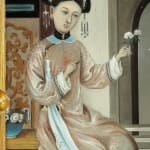A PAIR OF CHINESE EXPORT REVERSE-PAINTED MIRRORS
W: 21.75” / 55cm
Further images
Provenance
Private Collection: Copenhagen, Denmark
Literature
M. Jourdain & R. Soame Jenyns, Chinese Export Art in the Eighteenth Century (London: 1950)
Audric, Thierry, Chinese Reverse Glass Painting, 1720-1820: An Artistic Meeting Between China and the West (Bern, 2020)
Ferguson, Patricia F., ‘Reflecting Asia: The Reception of Chinese Reverse Glass painting in retain, 1748-1770’, pp. 157-73, in F. Giese, H. B. Thomsen, E. Ambrosio, A. Martimyanova (eds.), China and the West: Reconsidering Chinese Reverse Glass Painting, Volume 1 (Berlin & Boston, 2022)
Wirgin, Jan, Från Kina till Europa, Östasiatiska Museet (Stockholm, 1998)
COMPARE
Pair formerly in the Horlick Collection, sold Sotheby’s 5th June 2007, Lot 7
Pairs illus. Audric, Chinese Reverse Glass Painting (2020), pp. 188-91, nos. 157-8 and 179-80
Pair in the Museum of Far Eastern Antiquities, Stockholm, illus. Wirgin, Från Kina till Europa (Stockholm, 1998), p. 296, fig. 305
A pair of mid-eighteenth-century Chinese export reverse-painted mirrors depicting ladies in fine interiors, the first lady with gaoliang Manchu style hair, the second with a simple chignon signifying respectively their married and unmarried status, the plates bevelled and within mid-eighteenth-century giltwood frames carved with pilasters, c-scrolls, cabochons and leaves and flowers.
The subject most frequently depicted in eighteenth-century Chinese mirror paintings is the Beautiful Women, often painted alone and in small groups or in the company of male characters whose presence is simply to enhance the woman’s grace and beauty.
The most important examples of this genre were created as pairs, allowing the characters and motifs to take on a symbolic significance, with concepts often set against one another. For example, indoor-outdoor and winter-summer oppositions are well known, sometimes expressed as an elegant lady of the court seated in a richly adorned pavilion next to a hatted shepherdess sitting amongst lush nature and youthful animals. Music-poetry pairs and old age-youth comparisons were also painted.
The present paintings depict the married woman-unmarried girl duality, an especially rare motif. In the first painting, the lady wears her hair in the typical gaoliang way, with a chignon fashioned around a piece of wood positioned horizontally across her head, signifying the lady’s married status. In the second painting, the girl wears a simple chignon standing up vertically on her head, indicating that she is an unmarried Manchu woman.
The Manchu, who ruled China during the Qing dynasty (1644-1911), assigned the highest symbolic importance to hairstyles, decreeing that all men, both Manchu and Chinese, wear their hair in a plait, and that their wives wear the Manchu style described. The hair was often then richly decorated with jewels and flowers, as in the present paintings, where the gaoliang hair is also adorned with the typical feature of hairpins holding three hanging pendants that swing gracefully whenever the lady moves her head.
The two women are depicted in nearly identical interiors, which is typical for this opposition. The married lady is seated on a railed veranda opened to the outside by withdrawn curtains. Likewise, the unmarried lady is beside an open window with drapery tied overhead. The married-unmarried opposition is explored further by the first lady who holds a pair of flowers, representing a married couple, and the second lady who holds a pin cushion, perhaps a symbol to a potential husband of marital virtue, and stands leaning, looking longingly out of the window, waiting.
The present pair is closely comparable to a pair formerly in the Horlick Collection that depicts the married woman-unmarried girl opposition. In the first painting, a young woman with Manchu style hair is seated on a veranda again opened to the outside by the tied-back curtain. She holds a flower in her hand like the married woman of the present first painting. The setting in the second painting is almost identical. A young girl wearing a simple chignon, just as the girl in the present second painting, sits at a table holding a flower in her hand.
In the same way, the present pair compares to other examples of the married woman-unmarried girl opposition, namely the pair in the Museum of Far Eastern Antiquities, Stockholm and the two pairs illustrated in Audric, Chinese Reverse Glass Painting (2020), pp. 188-91, nos. 157-8 and 179-80.
The present mirrors are painted in exquisite fine detail characteristic of the very best Chinese export reverse-painted mirrors, which are a symbol of this fascinating international trade and cultural exchange in the eighteenth century between China and Europe.







